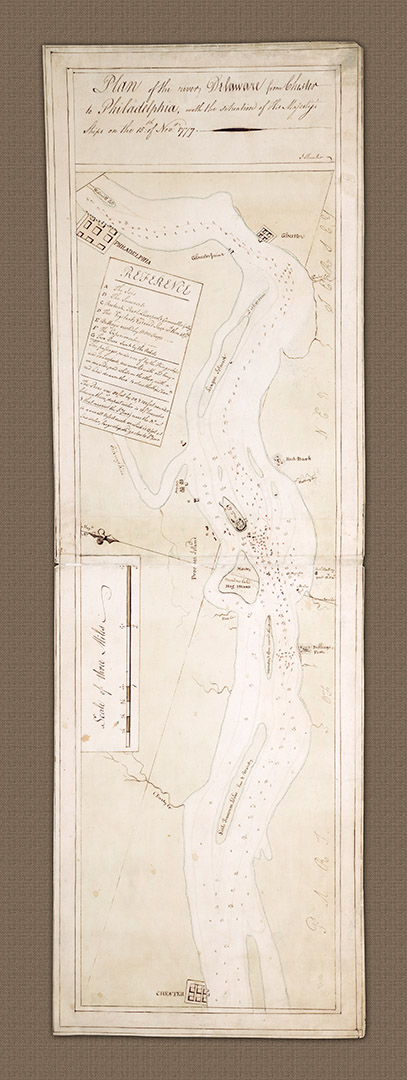The detail presented here by Hunter is simply astonishing. This section of the river was of great significance to both the Americans and the British as it gets closer to Philadelphia, which was then the largest city in America and, temporarily, the fledgling Nation's Capital.
Hunter's plan clearly shows the navigable course for ships sailing up the river, through the maze of defenses prepared by the Americans. The location of the Chevaux-de-Frizes', sunken, sharpened, stakes with metal tips [1] were designed to force ships under the guns of the adjacent forts was of course carefully plotted. Hunter uses a red line to point the way and the key to the map instructs ships to keep between the red and the white buoys laid-out.
On his later depiction of Hunter's plan, Des Barres expanded the key to include an individual letter for each of the British ships in position that day, but the information is still the same. The hydrograpical information: soundings, sand-banks and the like are also identical.
Lieutenant John Hunter was part of a team of surveyors and hydrographers who worked closely together at this time under the British, charting the important rivers of the Middle States. These Middle States were extremely valuable to both the Colonial powers and to the invading British forces as they afforded such good access into the interior. Captain Andrew Snape-Hammond summed the situation extremely well when he wrote 'on account of the Navigable Rivers of this Country, there is no part of this Country, there is no part of the continent where ships can assist land operations more'. He was writing of the Chesapeake at the time but he might just as well have been writing of the Delaware. The principle was the same (see Heritage Charts A302).
Captain Snape-Hammond had, himself, reconnoitered and surveyed the river between March and May of 1776 and had reported the state and position of rebel defenses to Admiral Richard Howe and to his brother General William Howe before they set-out on their campaign in July 1776 to capture Philadelphia (see also Heritage Charts A205).
As history would have it, General Howe's decision to turn British attention south, to capture Philadelphia after securing New York, rather than pushing North to join with General Burgoyne in Albany, ultimately proved fatal to the British campaign to retain their American colonies. Howe's decision to attack Philadelphia by sea rather than to press through by land from New Jersey, again, only served to take the pressure off Washington's retreating army, giving them a valuable month with which to regroup.
[1]. https://www.youtube.com/watch?v=f59kzeh9hm4
This hand-drawn plan or survey of the River Delaware from Chester up to Philadelphia by Lieutenant John Hunter shows the position of British naval force and the American defenses, as of the 15th November 1777. The plan was prepared, after the event by Hunter as part of the account of British preparations for the attack on Philadelphia. It was later taken by J.F.W. Des Barres for inclusion in the second edition of the Atlantic Neptune Atlas (1780, vol 4), as the upper section of his split-plan for the navigation of the river (see Heritage Charts A305).


